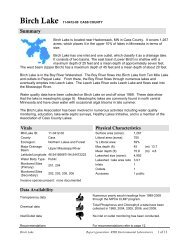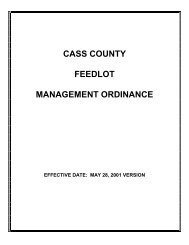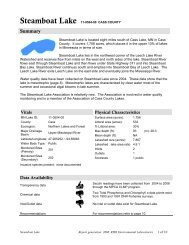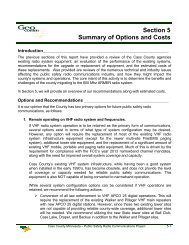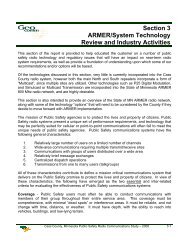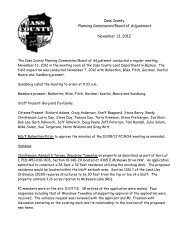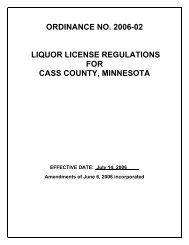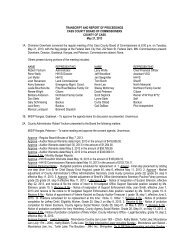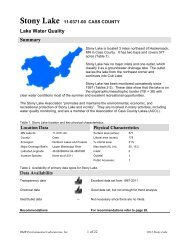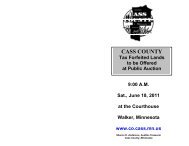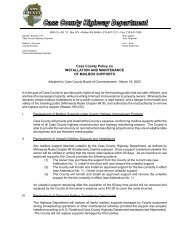Capital Improvement Plan - Cass County, Minnesota
Capital Improvement Plan - Cass County, Minnesota
Capital Improvement Plan - Cass County, Minnesota
- No tags were found...
You also want an ePaper? Increase the reach of your titles
YUMPU automatically turns print PDFs into web optimized ePapers that Google loves.
proposed facility or equipment will duplicate existing facilities or there is insufficientdemand for the facilities. If the plan is disapproved by the Commissioner, it may besubmitted to the voters in referendum form for approval.E. Organization of <strong>Cass</strong> <strong>County</strong> Finances<strong>County</strong> financial operations are organized in funds and departments in accordancewith state law and generally accepted accounting standards. The CIP is presented inmajor functional categories that include several individual funds and departments:1) Courts2) Environmental Services3) General Government4) Health, Human, and Veterans Services5) Land6) Management Information Systems7) Roads8) SheriffF. Our <strong>Plan</strong> by Major Function1) Courtsa) Purchase excess AhGwahChing land (54 acres) for a future courthousecampus site.b) Decline expanding the courthouse by two additional floors over presentlocal jail (see needs study dated June 18, 2002).c) Maintain an operating budget capable of minor remodeling.2) Environmental Servicesa) Phase in a “tip” fee for the actual cost of solid waste disposal based onvolume disposed.b) Utilize a county wide solid waste special assessment to fund recycling,solid waste administration, and public nuisance abatement not covered byindividual special assessments.c) <strong>Capital</strong> participation should include the transfer station operator whereappropriate.d) Equipment replacement program for transfer station should be formalized.3) General Governmenta) Table to a date uncertain the expansion of the courthouse annex to theexisting south parking lot.b) Limit capital investment in the <strong>Cass</strong> <strong>County</strong> Museum to maintenance untilpermanent site capable of long-term expansion is found.c) Replace voting equipment to provide for disabled voter access per federallaw by 2006.3
d) Sell Pine River Resource Center and relocate remaining Extension andsouthern government center activities to a relocated Land Departmentfacility.e) Move Sheriff Boat & Water program to former Council on Aging office.f) Expand buildings and grounds to MHB space when vacated.4) Health, Human, and Veterans Servicesa) Future expansion priority is to co-locate in other public facilities to provideservices throughout the county5) Landa) Replace present remodeled church and maintenance facilities with asouthern service center with improved access to Hwy #371 and sufficientland to accommodate consolidated highway shops, Pine River ResourceCenter and other general government services.b) Purchase conservation easements that provide a no net gain/loss to theproperty tax capacity as funds are available.c) Establish a priority list for trail destination corridors per the comprehensiveplan.6) Management Information Systemsa) Replace dispatch console to improve 911 locate information available forfirst responders and increase work stations from 2 to 3.b) Maintain individual property address signs on a fee basis and roadintersection signs on a county wide basis.c) Replace desktop computer systems on a four year cycle. Replace networksystems as required.d) Internally prepare the county plat book and enter into a distributionagreement with 4H.e) Improve public access to parcel mapping program by reducing cycle timeon the internet.f) Expand web based services to additional interactive uses.g) Maintain an electronic inventory of facilities and equipment.h) Replace courthouse and annex phone system7) Roadsa) Expand county road program:1) Gravel maintenance for roads of less than 100 ADT.2) CaCl maintenance for roads of more than 100 ADT.3) Bituminous maintenance for roads of more than 150 ADT.b) Improve volume of public land survey corner monumentation.c) Consolidate maintenance sites from six to four.4
d) Maintain an equipment fleet cycle of:1) Heavy equipment – 12 years2) Heavy trucks – 10 years3) Light trucks – 140,000 to 150,000 miles4) Passenger vehicles – purchase used at 30,000 to 40,000 miles,replace at 140,000 to 150,000 milese) Maintain a safety betterments program of striping, signage, andintersection lights.8) Sheriffa) Maintain county jail facilities attached to the courthouse. Needs in excessof the county facility will be met through contracting bed space withneighboring counties or equity participation in a regional jail.b) If AhGwahChing is determined to be the regional jail site, state bondingwill be sought to cover the cost of any demolition and 50% of theconstruction cost. Contract commitments will be sought from neighboringcounties, state, and federal agencies.c) Maintain vehicle fleet replacement schedule of 100,000 miles.d) Consider expanding county issued standardized equipment to handguns.e) Maintain an operating budget capable of minor remodeling.G. Funding Required by Project and Source to Meet the CIPProgram Project Source $ AmountCourts AhGwahChing land Fund balance 1Replace Courthouse Bonds UndeterminedMinor remodeling Annual budget 4,000ESD Disposal tip fee Annual budget 600,000SW assessment Annual budget 1,600,000Transfer station Fund balance 750,000Gen. Gov’t. Annex expansion Bonds Tabled<strong>County</strong> museum Fund balance UnknownVoting equipment Fund balance 300,000Sell resource center Fund balance 50,000Move offices Annual budget 1,000Telephone system Fund balance 50,000HHVS Co-location Annual budget VariesLand Replace facilities Fund balance 850,000Easements Fund balance VariesTrails Fund balance Unknown5
MIS Dispatch console Fund balance 145,000911 signs Annual budget 10,000Computers Annual budget 165,000Plat book Annual budget 10,000Parcel mapping Fund balance 90,000Web improvements Annual budget VariesDigital inventory Annual budget 5,000Roads Gravel program Annual budget 80,000CaCl program Annual budget 300,000Paving program Bonds 3,570,000Public survey Annual budget 25,000Consolidate shops Bonds 2,000,000Equipment Annual budget 250,000Safety betterments Annual budget 125,000Sheriff Contract beds Annual budget 200,000Regional jail Bonds 12,000,000Vehicles Annual budget 150,000Handguns Annual budget 30,000Minor remodeling Annual budget 20,000H. Funding Options for CIP ProjectsSummary Annual budget 3,575,000Fund balance 2,235,001Bonds 17,570,000The projects identified utilizing the annual budget as a source of funds are by theirnature to be considered annually.The projects identified utilizing fund balance as a source of funds are considered whenthe funds designated by the Board of Commissioners, state law, or grants aresufficient to start or complete a project.The projects identified utilizing bonds as a source of funds are those projects that areof an immediate nature, but cannot be supported by the annual budget or availablefund balance. In this situation, the county can consider long term financing (bonds).I. Types of CIP Long Term FinancingGeneral Obligation Bonds Authorized by Special Election: <strong>Minnesota</strong> Statutes,Chapter 475, allows general obligation bonds to be issued for building purposes in anamount up to the county’s debt limit. This requires a vote of the public and must beapproved by one vote more than 50% of those voting. The tax levy for debt service is6
spread on the basis of market value (rather than net tax capacity, as all other optionsrequire).Courthouse Bonds: <strong>Minnesota</strong> Statutes, Section 375.18, allows general obligationbonds to be issued for courthouse improvements without a hearing or election up to.0004030 times taxable market value: .0004030 X $3,198,442,200 = $1,288,972. Thisis the total principal amount of General Obligation Courthouse Bonds that may beoutstanding at any one time.<strong>Capital</strong> <strong>Improvement</strong> <strong>Plan</strong>/Bonds: <strong>Minnesota</strong> Statutes, Chapter 373.40, allowscounties to issue general obligation bonds for purposes defined in the <strong>Capital</strong><strong>Improvement</strong> <strong>Plan</strong>. The annual obligation of debt cannot exceed .0005367 timestaxable market value. Currently for <strong>Cass</strong> <strong>County</strong>, this would be .0005367 X$3,198,442,200 or $1,716,604. This annual debt obligation would support about$17,500,000 financed over 15 years at 5.50% interest, as an example.For a county to pursue financing of projects under MS 373.40, it must fulfill therequirements of the chapter. Specifically, the <strong>County</strong> Board must approve a sale of<strong>Capital</strong> <strong>Improvement</strong> Bonds by a 3/5th majority. In addition, it must hold a publichearing for public comment. Notice of such a hearing must be published in the officialnewspaper of the county 14 to 28 days prior to the public hearing. Although noreferendum is required, a reverse referendum is allowable. If an election petitionbearing the signatures of 5 percent of the votes cast in the last general electionrequesting a vote on the issuance of the bonds is received by the Auditor within 30days after the public hearing, a referendum vote on the issuance of the bonds shall becalled.No such petition has been received by the <strong>Cass</strong> <strong>County</strong> Auditor-Treasurer on anyproposed bond issues since the adoption of this plan.Jail Bonds: <strong>Minnesota</strong> Statutes, Section 641.23, allows the county to issue generalobligation bonds authorized by Board resolution with project approval by theCommissioner of Corrections. These bonds may be issued for jail and other lawenforcement facilities. Annual debt service may not exceed .0009671 times taxablemarket value: .0009671 X $3,198,442,200 = $3,093,213. This would support about$31,550,000 matured over 15 years at 5.50%, as an example.Jail/law enforcement facility financing may also be accomplished under <strong>Minnesota</strong>Statues, Section 641.24, with bonds of a city within the county or a county housing andredevelopment authority that are backed by a general obligation lease-purchaseagreement. The city or authority enters into a lease purchase agreement with thecounty, and the county (as lessee) makes payments over a period of time to the lessorin an amount sufficient to cover the bond principle and interest. Annual rentals maynot exceed one -tenth of one percent of taxable market value: .001 X $3,198,442,200 =$3,198,442. This would support about $32,625,000 matured over 15 years at 5.50%,as an example.7
Annual Appropriations Lease-Purchase Financing: This form of financing requires alease-purchase agreement between the county and the “lessor” which can be an HRA,and EDA, or other entity which owns the facility during the time lease payments arebeing made to cover the principal and interest on the bonds. At the end of thepayments, the county becomes the owner of the facility. This is considered “debt” fordebt limit purposes if the principal amount is more than $1,000,000, and does notrequire an election. Debt service levies are special levies under the category “bondsof another governmental unit” of an HRA or EDA is used. The bonds are not generalobligations of the county but rather are subject to annual allocation.Other Financing Options: Solid waste projects can be financed with GeneralObligation (G.O.) Solid Waste Bonds (<strong>Minnesota</strong> Statutes {M.S.}. Section 115.46) andG.O. Solid Waste Revenue Bonds (M.S. Section 400.10). Counties may issue G.O.<strong>Capital</strong> Notes (M.S. Chapter 373) to finance road construction, public safety, medical,and data processing equipment. State aid payments can be pledged to retire generalobligation bonds sold to finance state aid road improvements (M.S. Chapter 162).J. Statutory Debt LimitsIn addition to limitations on annual budgets, and use of fund balances, limitations applyto indebtedness.First under MS 475, with few exceptions, counties cannot incur debt in excess of 2% ofthe assessor’s taxable market value for the county. In <strong>Cass</strong> <strong>County</strong> the TMV is$3,198,442,200. Therefore, the total amount of outstanding debt cannot exceed$63,968,844. <strong>Cass</strong> <strong>County</strong> 12/31/03 outstanding bonded indebtedness is $0.Another limitation on bonding under the CIP (MS 373.40) is that without referendum,the total amount that can be used for principle and interest in any one year for CIPdebt cannot exceed .05367% of TMV. In <strong>Cass</strong> <strong>County</strong> that amount is $1,716,604($3,198,442,200 x .0005367). Since <strong>Cass</strong> <strong>County</strong> has no outstanding CIP debtpresently, the maximum levy today would be $1,716,604 per year to retire debt.K. Possible Debt for fiscal Years 2004 – 2009The Board of Commissioners have determined that the annual budget and fundbalances are not sufficient to meet the following CIP project funding requirements, andtherefore, may be subject to bonded indebtedness:In the years 2004 – 2009:Program Project $ AmountRoads Consolidate shops 2,000,000Paving program 3,570,000Sheriff Regional Jail 12,000,0008
In the years after 2009:Courts Courthouse replacement UndeterminedGen. Gov’t. Annex expansion TabledAdoption of or amendments to this <strong>Capital</strong> <strong>Improvement</strong> <strong>Plan</strong> do not constituteapproval of any individual project or a commitment to provide financing of any kind.The plan represents the Board of Commissioners best efforts to plan <strong>Cass</strong> <strong>County</strong>’sfuture within the limits of state law and the affordability of its constituents.L. List of Related Exhibits"A" Affidavit of Publication - notice of hearing"B" Certified extract of <strong>County</strong> Board minutes1. 07/20/992. 0122/013. 12/16/03"C" <strong>Cass</strong> <strong>County</strong> outstanding debt 12/31/02"D" Current 12/31/02 indirect debt of <strong>Cass</strong> <strong>County</strong>“E” Inventory of Facilities“F” Inventory of EquipmentRespectfully submitted,Robert H. Yochum<strong>County</strong> Administrator9



